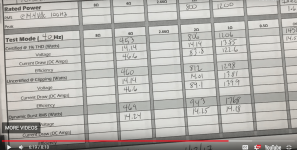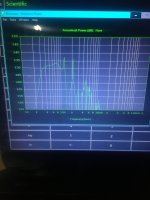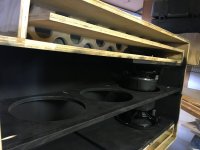Hi, consulting the forum for some wisdom
Summer is over and time to upgrade the12vbattery sound system, searching some guidance on what is the best route forward
Currently using 3x tham15s, parallelled on a classD amp, doing only dj-gigs, and it sounds downright amazing after some proper tuning.
But I cant shake the sensation that I would appreciate more low end, and I am prepared to go 18", but I would like to discuss another option as well.
I am hounted by the thought: "If I just could find a way to squeeze 5hz more down low (+psychoacoustic bass enhancement algorithm) , MAYBE I would be satisfied with 3 more thams to fullfill my childish dream of 2x3 vertical stacks, instead of replacing the whole rig".
Did anyone try a 45hz bass boost with a steep HPF to sqeeze some extra low end on the tham15s? Or should I just accept that a 15"TH is not a 18" before I brake anything?
Would some barn doors on a vertical 3x stack boost low end, or just raise db of the entire bassband?
So I have been looking around for other options, and I am considering the Keystone and the Th18. From what I have been able to find, there are some reports that the keystone is a little more sensitive than the th18, wich is an important factor when limited amp power. Any other cab designs that should be mentioned?
I am a little concerned about going 18" in regards to amp power. Anyone got info about the powerfactor needed for 10hz more in low end with same amount of speakers at same volume?
Questions summarized:
1. Thoughts on a 45hz bass boost with a steep HPF to sqeeze some extra low end on the tham15s?
2. Would some barn doors on vertical 3x stack boost low end, or just raising entire passband?
3. Other TH-cab designs would be suitable?
4. Additional powerfactor required for 18" - 40hz and up in relation to thams15s 50hz and up?
Appreciate all inputs
Sincerly,
kris
Summer is over and time to upgrade the12vbattery sound system, searching some guidance on what is the best route forward
Currently using 3x tham15s, parallelled on a classD amp, doing only dj-gigs, and it sounds downright amazing after some proper tuning.
But I cant shake the sensation that I would appreciate more low end, and I am prepared to go 18", but I would like to discuss another option as well.
I am hounted by the thought: "If I just could find a way to squeeze 5hz more down low (+psychoacoustic bass enhancement algorithm) , MAYBE I would be satisfied with 3 more thams to fullfill my childish dream of 2x3 vertical stacks, instead of replacing the whole rig".
Did anyone try a 45hz bass boost with a steep HPF to sqeeze some extra low end on the tham15s? Or should I just accept that a 15"TH is not a 18" before I brake anything?
Would some barn doors on a vertical 3x stack boost low end, or just raise db of the entire bassband?
So I have been looking around for other options, and I am considering the Keystone and the Th18. From what I have been able to find, there are some reports that the keystone is a little more sensitive than the th18, wich is an important factor when limited amp power. Any other cab designs that should be mentioned?
I am a little concerned about going 18" in regards to amp power. Anyone got info about the powerfactor needed for 10hz more in low end with same amount of speakers at same volume?
Questions summarized:
1. Thoughts on a 45hz bass boost with a steep HPF to sqeeze some extra low end on the tham15s?
2. Would some barn doors on vertical 3x stack boost low end, or just raising entire passband?
3. Other TH-cab designs would be suitable?
4. Additional powerfactor required for 18" - 40hz and up in relation to thams15s 50hz and up?
Appreciate all inputs
Sincerly,
kris
One ROAR18 will easily match two THAM15 in output. And it will go at least 5 Hz lower.
https://www.martinsson.cc/blog/index.php?m=03&y=17&entry=entry170302-170401
https://www.martinsson.cc/blog/index.php?m=03&y=17&entry=entry170302-170401
Kris,1. Thoughts on a 45hz bass boost with a steep HPF to sqeeze some extra low end on the tham15s?
2. Would some barn doors on vertical 3x stack boost low end, or just raising entire passband?
3. Other TH-cab designs would be suitable?
4. Additional powerfactor required for 18" - 40hz and up in relation to thams15s 50hz and up?
1. The THAM15 impedance/excursion minima is around 45 Hz, while response is down nearly -6dB, so boosting at that frequency with a steep HPF will use around +6dB more power to flatten response, a lot more battery power.
2. The entire passband will be increased on axis, more upper than lower. That said, barn doors may cut your power requirement in half on average, which would cancel out most of the additional power used at the less efficient low end of the response.
3. Sure, bigger is better for efficiency, and TH are no exception, but require longer horn path lengths for lower frequencies.
4. 18” is more efficient than 15” for drivers in the same power, excursion and magnet strength range.
Low frequency extension reduces efficiency unless size is increased substantially.
For your application relying on battery power, larger TH cabinets like the Keystone or ROAR18 will reduce power demands in the low end, but are 2-3 times the size of the THAM15.
Art
I'd love to know more about your rig, do you have details posted anywhere or a social media presence for it?
What amps are you running, and what voltage swing can they put out?
Sensitivity is key, since you'll never reach the max output of these big boxes...
This is part of the 12V conundrum I'm in too - is it worth pushing for a few Hz lower but doubling your box volume? All depends how you transport and store it I guess.
What amps are you running, and what voltage swing can they put out?
Sensitivity is key, since you'll never reach the max output of these big boxes...
This is part of the 12V conundrum I'm in too - is it worth pushing for a few Hz lower but doubling your box volume? All depends how you transport and store it I guess.
Grey line is two THAM15 loaded with the recommended B&C 15TBX100-4. 2000 watt per driver and 11 mm Xvar.
Green/Red line is a single ROAR18 loaded with the recommended B&C 18DS115-4. 3400 watts and 14 mm Xvar.
One single ROAR18 is slightly larger then two THAM15. You gain 5 Hz or so of downward extension for the ROAR18 compared to two THAM15. The midbass peak of the ROAR does add at least 6 dB of available output in the dead center of where most of the energy in modern music is centered.
The ROAR series sounds better then the THAM series (in my experience - but this is rather subjective) with a more pronounced midbass punch and "drive".
Or a ROAR 15. I've got 4 of them and they kick out an awful lot of noise and go very deep. For the same given input, 1 of them creates about the same output as 2.5 or perhaps 3 of my other subs that utilise the same driver.
12v battery sound system
🤔2000 watt per driver... 3400 watts ...
Let's find out what the amps can do, before talking about absolute limits of drivers - just to keep things realistic
Tanks for the detailed response, Art, and thanks for all the other inputs, Bitsmasher, Circlomanen, Booger and Damo.
after some carefull thinking and planning, I have decided to build some 18" th this winter. The Tapped-Horn-Anders-Martinssons are an amazing compromize between size and output/extension, and they will be my "lightweight/portable" system, i will build another bigger system for larger events. I have considered some options, and have decided to go with the keystone. This bcs of sensitivity, fewer cuts, and artistic design goals. Speakers will have a visual appearence as well as auditory, and the keystone provides more surface area for my design artists to go bananas, especially in regards to front panel. I will start by building four this winter, and maybe two more next winter. ATM i am using a MTM version of Peter Morris double 10" + horn, for tops, but I will upgrade to two proper PM90 deg to match relative output of the new stack of subs.
Regarding artistic design, some-one in my crew was wondering if its possible to put two standing keystones on top of eachother each side, bottom one upside down, for symmetry purposes. I know the "one rig pr side of stage" is not optimal, and causes weird pattern control like power alleys and cancellations across the dance floor, but the visual aspect is also a factor. I would love for in-line and gradient cardiod sub arrays to look as cool, unfortunately i dont think they do. But thats another discussion. Question #1: will two standing tapped horns on top of each give weird pattern control in any way?
Bitsmasher, I am running 12v amps, atm i am using a pioneer gm-d9601 to power 3 thams in parallell. According to specs (and dyno test actually), its able to output about 1200w @ 1ohm, and 500 @ 4 ohm. Three thams (15ps100-8) in parallell gives a working load that dips in to 1,73 ohm according to hornresp, so i guess somewhere between 700-900w total? thats the best answer i can give regarding available power. Its not much, but its downright amazing how much you can get out of few watts if sensitivity is right. with my limited amount of power I find the DB pr 2,83v pr meter sensitivity a much more relevant parameter than voltage before xmax as you mentioned in last post. yeah, the 12v-corundrum... I guess I found peace with using bigger speakers, just need to buy a bigger van😆 The current system do not have a social media presence, but maybe it should, it gained some praise and reputation in my home town for remote off grid parties. I guess the new sound system most def should have a social media presence. You also into 12v portable solutions? can I find yours somewhere online?
I am looking at drivers for the keystone. If unlimited funds, I would have opted for the 18NLW9601 (or the 18SW115), but since the price range for these are in a class for itself, and since they will not see the amounts of power requiered to get close to xmax any time soon, maybe it would be unnecessary to spend that amount on drivers. But one could argue that I will stop these nomadic off grid events in the future, connect my system to a standard power socket in the wall somewhere, buy a decent amp and regret not going with expensive drivers... 😆 So i have currently narrowed it down to the 18lw2400, 18tbx100 and 18nw100. Question #2: Wich one of these drivers would you forge in the Keystone sub? Am I on the right track with this?
I wonder how many speakers I can connect i parallell on my amp. It says it is 1 ohm stable, wonder if i should take this seriously. There is a dyno test for this particular amp on yt,
, and according to the numbers it actually seems to be more efficient for 1 ohm (71%) than for two ohm (64%). Question #3: Are there any reasons to not put 4 subs parallel on one amp when 1 ohm stable?
after some carefull thinking and planning, I have decided to build some 18" th this winter. The Tapped-Horn-Anders-Martinssons are an amazing compromize between size and output/extension, and they will be my "lightweight/portable" system, i will build another bigger system for larger events. I have considered some options, and have decided to go with the keystone. This bcs of sensitivity, fewer cuts, and artistic design goals. Speakers will have a visual appearence as well as auditory, and the keystone provides more surface area for my design artists to go bananas, especially in regards to front panel. I will start by building four this winter, and maybe two more next winter. ATM i am using a MTM version of Peter Morris double 10" + horn, for tops, but I will upgrade to two proper PM90 deg to match relative output of the new stack of subs.
Regarding artistic design, some-one in my crew was wondering if its possible to put two standing keystones on top of eachother each side, bottom one upside down, for symmetry purposes. I know the "one rig pr side of stage" is not optimal, and causes weird pattern control like power alleys and cancellations across the dance floor, but the visual aspect is also a factor. I would love for in-line and gradient cardiod sub arrays to look as cool, unfortunately i dont think they do. But thats another discussion. Question #1: will two standing tapped horns on top of each give weird pattern control in any way?
Bitsmasher, I am running 12v amps, atm i am using a pioneer gm-d9601 to power 3 thams in parallell. According to specs (and dyno test actually), its able to output about 1200w @ 1ohm, and 500 @ 4 ohm. Three thams (15ps100-8) in parallell gives a working load that dips in to 1,73 ohm according to hornresp, so i guess somewhere between 700-900w total? thats the best answer i can give regarding available power. Its not much, but its downright amazing how much you can get out of few watts if sensitivity is right. with my limited amount of power I find the DB pr 2,83v pr meter sensitivity a much more relevant parameter than voltage before xmax as you mentioned in last post. yeah, the 12v-corundrum... I guess I found peace with using bigger speakers, just need to buy a bigger van😆 The current system do not have a social media presence, but maybe it should, it gained some praise and reputation in my home town for remote off grid parties. I guess the new sound system most def should have a social media presence. You also into 12v portable solutions? can I find yours somewhere online?
I am looking at drivers for the keystone. If unlimited funds, I would have opted for the 18NLW9601 (or the 18SW115), but since the price range for these are in a class for itself, and since they will not see the amounts of power requiered to get close to xmax any time soon, maybe it would be unnecessary to spend that amount on drivers. But one could argue that I will stop these nomadic off grid events in the future, connect my system to a standard power socket in the wall somewhere, buy a decent amp and regret not going with expensive drivers... 😆 So i have currently narrowed it down to the 18lw2400, 18tbx100 and 18nw100. Question #2: Wich one of these drivers would you forge in the Keystone sub? Am I on the right track with this?
I wonder how many speakers I can connect i parallell on my amp. It says it is 1 ohm stable, wonder if i should take this seriously. There is a dyno test for this particular amp on yt,
You're right, with efficient speakers it's pretty impressive how a "real" few hundred watts can sound.
That Pioneer amp looks good for 40V RMS, by calculating back from the specs. Note that they're given at 14.4V input, and 12V batteries will generally sit a fair bit lower than that depending on the chemistry.
Something I want to explore when I have time is amp output based on input voltage, I have a Pioneer GM-D8500M and a couple of other big mono Class D amps, am curious what output they'll give in real world conditions as battery voltage drops over time.
A local off-grid system, DIY HiFi, have recently added Keystones to their setup - they're a pretty clever crew so I'd see that as a nod to the box as a good design for balance of size, efficiency and output for a battery powered system. Check out that build thread on Speakerplans, it's a good read.
My pursuits are niche and very compromised, since it has to be transported by bicycle: https://www.instagram.com/batteryacidsoundsystem/
I will have to create a new build thread when I start on the next system, hoping to make some sawdust to have it rolling in time for our (Melbourne) summer.
That Pioneer amp looks good for 40V RMS, by calculating back from the specs. Note that they're given at 14.4V input, and 12V batteries will generally sit a fair bit lower than that depending on the chemistry.
Something I want to explore when I have time is amp output based on input voltage, I have a Pioneer GM-D8500M and a couple of other big mono Class D amps, am curious what output they'll give in real world conditions as battery voltage drops over time.
A local off-grid system, DIY HiFi, have recently added Keystones to their setup - they're a pretty clever crew so I'd see that as a nod to the box as a good design for balance of size, efficiency and output for a battery powered system. Check out that build thread on Speakerplans, it's a good read.
My pursuits are niche and very compromised, since it has to be transported by bicycle: https://www.instagram.com/batteryacidsoundsystem/
I will have to create a new build thread when I start on the next system, hoping to make some sawdust to have it rolling in time for our (Melbourne) summer.
i have two 9701 on 2 12” skar ddx12 in a roar.. great amps for the price (about a year or so ago when things weren’t stupid expensive suddenly)
I agree the Keystone is sexy as heck
I agree the Keystone is sexy as heck
😝😝😝Ya gotta luv speaker p0rn..."it's now called the "Strap-On Soundsystem!""
Attachments
Kris,Question #1: will two standing tapped horns on top of each give weird pattern control in any way?
Question #2: Wich one of these drivers would you forge in the Keystone sub? Am I on the right track with this?
Question #3: Are there any reasons to not put 4 subs parallel on one amp when 1 ohm stable?
A few points before answering your 3 questions, expanding on bitSmashers responses.
The “12 volt conundrum” is a real problem, you have not yet mentioned your battery voltage, type, amp hours, or it’s voltage drop under load.
A fully charged lead acid battery is around 12.6v fully charged, at 50% capacity, it has dropped to 12.06 volts. Depending on the battery bank’s ampacity, it may drop far below that voltage under load, and Peukert’s effect may drop voltage further if you have less than around 250 amp hours capacity, requiring 2-3 group 27 marine batteries.
The Pioneer GM-D9601 amplifier one ohm test drew 122.6 amperes at 13.85 volts (1836 watts drawn) putting out 1206 watts @1% distortion, 65.9% efficient.
To put out that much power at 12volts would require 153 amperes from the battery, while the amplifier is fused at 120amps (3x40amp).
The GM-D9601 put out 42.5volts, (453watts at 4 ohms at 14.4v, 67.3% efficient), dropping to 40.1v at 2 ohms (806 watts at 13.81v, 66.9% efficient) and 34.7v at 1 ohm (1206 watts).

The amp has current limiting to prevent too much power being drawn, also evident from less power output in the burst tests with a .8 ohm load.
Question #1: Two subwoofers stacked vertically will reduce their vertical dispersion, horizontal dispersion will be largely unchanged.
Question #2: Driver selection based on the limited voltage available from your Pioneer GM-D9601 amp lead to lighter mass, low impedance choices for the most output. Of the choices you presented, the B&C18TBX100-4 would probably result in the most output for four cabinets driven from your amp .
That said, with 12 volt inverters and 120/240 volt Class D amplifiers running at around 90% efficiency, you could do better using them, and go with drivers that have more output capability …
Question #3: Other than “putting all your eggs in one basket”, (and the relatively poor efficiency) nothing much wrong in 4 subs driven parallel on a single one ohm capable amplifier.
Art
Hey, I would like to share some brazilian tips about power. We have in here lots of 12V class D amps with low distortion and high (90%) efficiency. Some of our brands are actually pretty world class on that niche. If you search for "paredao de som", you will see large projects running from 12V batteries, although sometimes in series (100~300V).
I am attaching a couple of manuals of high powered 12V products of a brand I like.
And, of course, your dollar powered money will make these look pretty affordable.
I personaly drive two Keystones with a 8000w 12v SounDigital class D amp and it sounds pretty much the same as with an old AB amp I have arround. However, I wouldnt thrust these amps to run high-ish frequencies.
I am attaching a couple of manuals of high powered 12V products of a brand I like.
And, of course, your dollar powered money will make these look pretty affordable.
I personaly drive two Keystones with a 8000w 12v SounDigital class D amp and it sounds pretty much the same as with an old AB amp I have arround. However, I wouldnt thrust these amps to run high-ish frequencies.
Attachments
- Home
- Loudspeakers
- Subwoofers
- Keystone, Th18 or more tham15s?


